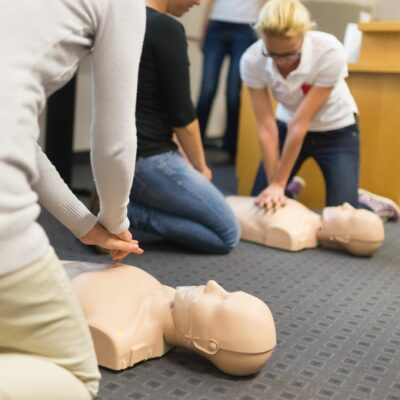Introduction
In our fast-paced globe, emergency situations can strike without caution. Whether it's a small injury, a clinical emergency situation, or a life-threatening scenario, knowing just how to provide first aid can make all the distinction. This is where a First Help course comes into play. Lots of people may question what they can obtain from such training, and this post aims to clarify that.
By joining in a First Aid and CPR course, you do not simply find out about wrapping injuries or doing mouth-to-mouth resuscitation; you furnish on your own with very useful skills that could save lives. So, just what will you learn in a comprehensive training course? Allow's basic first aid course study the details.
First Help Essentials: What You'll Find out in a Thorough Course
Understanding First Aid
What is Initial Aid?
First aid describes the preliminary support offered to a person suffering from an injury or ailment till expert clinical aid gets here. It encompasses various strategies and skills ranging from straightforward wound like lifesaving strategies like mouth-to-mouth resuscitation (Cardiopulmonary Resuscitation).
Importance of Emergency treatment Training
Why Should You Take an Emergency Treatment Course?
Taking a First Help course is essential for several factors:
- Confidence: Understanding how to respond in emergency situations can instill confidence. Life-Saving Skills: The capacity to carry out CPR or assist with choking can conserve lives. Career Development: Many careers call for qualification in very first aid. Community Duty: Being trained means you can aid others effectively.
Overview of CPR
What is CPR?
CPR, or Cardiopulmonary Resuscitation, is an emergency procedure done when someone's heart beat or breathing has actually stopped. It combines breast compressions with rescue breaths to maintain blood circulation and oxygenation up until professional assistance arrives.
The Structure of a Comprehensive Emergency Treatment Course
What Does an Emergency treatment Course Include?
A well-rounded First Aid and mouth-to-mouth resuscitation course commonly covers the following topics:
Introduction to First Aid Legal and Moral Considerations Scene Safety Basic Life Support (BLS) CPR Techniques Choking Relief Wound Care Management Burn Treatment Managing Shock Recognizing Clinical Emergencies Using an Automated External Defibrillator (AED)Legal Aspects of First Aid
Are There Legal Implications Involved in Providing First Aid?
Yes, supplying first aid does carry lawful responsibilities known as "Good Samaritan legislations." These laws shield people who aid others in emergency situations, supplied their actions are reasonable and not reckless.
Scene Safety: The First Step
How Do You Guarantee Scene Safety?
Ensuring scene safety includes assessing the setting before approaching the target:
- Look for prospective dangers (web traffic, fire). Make sure it's risk-free for both you and the victim.
Basic Life Assistance (BLS)
What Duty Does BLS Play in Emergency Situation Situations?

Basic Life Assistance includes the fundamentals of keeping life functions up until further medical assistance arrives. This section covers crucial abilities such as:

- Checking responsiveness Activating emergency solutions Performing high-quality chest compressions
Advanced CPR Techniques
What Are Advanced Techniques Covered in CPR Courses?
Advanced methods may consist of:
- Two-rescuer CPR Use of barrier gadgets for rescue breaths Special considerations for babies and children
Choking Relief Techniques
How Do You Assist Somebody Who is Choking?
Choking relief entails 2 important methods:
The Heimlich maneuver for adults. Back impacts and chest drives for infants.Wound Care Management
How Do You Properly Manage Wounds?
Effective wound monitoring includes:
- Cleaning the injury with saline or clean water. Applying antibiotic ointment. Covering it with clean and sterile dressings.
Burn Treatment
What Work Approaches for Treating Burns?

Burn treatment varies by Child Care First Aid Courses Near Me level:
Cool the burn under running water. Cover it with non-stick dressings. Seek clinical focus for severe cases.Managing Shock
How Is Shock Acknowledged and Treated?
Recognizing shock includes looking for symptoms like light skin, rapid pulse, or complication:
Lay the person down. Elevate their legs unless there are injuries preventing this. Keep them calm until assistance arrives.
Recognizing Clinical Emergencies
What Sorts of Medical Emergencies Need To You Know Of?
Common medical emergency situations include:
- Heart assaults Stroke Severe allergies Understanding these problems helps you act quickly.
Using an Automated External Defibrillator (AED)
How Do You Utilize an AED Correctly?
Using an AED entails turning it on, connecting pads according to illustrations on the device, and complying with voice prompts carefully.
Importance of Constant Learning
Why Is Continual Discovering Important in Emergency Treatment Training?
Continuous knowing ensures you stay updated on ideal practices and brand-new protocols in first aid care.
FAQs Concerning First Aid Courses
What Is Consisted of in a Standard First Aid Course?- A typical course normally covers basic life support, wound administration, choking relief strategies, and legal considerations.
- Most programs range from 6 hours to 16 hours depending upon the deepness of web content covered.
- Yes, upon effective completion of many programs, participants get a first help certificate, which is usually valid for two years.
- Yes! Several companies use on the internet training courses that offer adaptable learning environments while still being effective.
- Absolutely! Hands-on technique is critical for grasping abilities like chest compressions and making use of AEDs effectively.
- Generally, there are no age restrictions; nevertheless, participants must be emotionally competent to discover these life-saving abilities effectively.
Conclusion
Enrolling in an extensive first aid course furnishes individuals with essential knowledge that can save lives during emergency situations-- whether in the house, work, or out in public areas! From understanding fundamental life support procedures like mouth-to-mouth resuscitation to finding out exactly how to take care of injuries properly or recognize indicators of shock-- these courses offer important training that any individual can profit from!
As we browse via our lives filled with changability-- what much better method than preparing ourselves through understanding obtained from structured training sessions focused on saving lives?
In verdict-- if you're pondering occupying any kind of type of first-aid training-- never wait! Equip on your own today with these effective tools because preparedness absolutely makes all the distinction when every second counts!